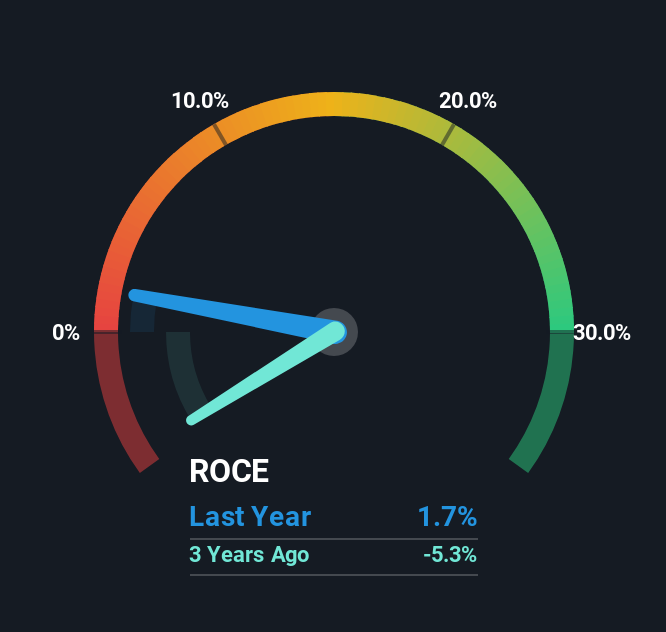- Romania
- /
- Construction
- /
- BVB:NAPO
Societatea de Constructii Napoca (BVB:NAPO) Could Be Struggling To Allocate Capital
What financial metrics can indicate to us that a company is maturing or even in decline? Businesses in decline often have two underlying trends, firstly, a declining return on capital employed (ROCE) and a declining base of capital employed. This combination can tell you that not only is the company investing less, it's earning less on what it does invest. Having said that, after a brief look, Societatea de Constructii Napoca (BVB:NAPO) we aren't filled with optimism, but let's investigate further.
Return On Capital Employed (ROCE): What Is It?
Just to clarify if you're unsure, ROCE is a metric for evaluating how much pre-tax income (in percentage terms) a company earns on the capital invested in its business. The formula for this calculation on Societatea de Constructii Napoca is:
Return on Capital Employed = Earnings Before Interest and Tax (EBIT) ÷ (Total Assets - Current Liabilities)
0.017 = RON1.2m ÷ (RON115m - RON47m) (Based on the trailing twelve months to March 2025).
So, Societatea de Constructii Napoca has an ROCE of 1.7%. In absolute terms, that's a low return and it also under-performs the Construction industry average of 4.2%.
View our latest analysis for Societatea de Constructii Napoca

Historical performance is a great place to start when researching a stock so above you can see the gauge for Societatea de Constructii Napoca's ROCE against it's prior returns. If you want to delve into the historical earnings , check out these free graphs detailing revenue and cash flow performance of Societatea de Constructii Napoca.
What The Trend Of ROCE Can Tell Us
The trend of returns that Societatea de Constructii Napoca is generating are raising some concerns. To be more specific, today's ROCE was 2.5% five years ago but has since fallen to 1.7%. On top of that, the business is utilizing 33% less capital within its operations. When you see both ROCE and capital employed diminishing, it can often be a sign of a mature and shrinking business that might be in structural decline. Typically businesses that exhibit these characteristics aren't the ones that tend to multiply over the long term, because statistically speaking, they've already gone through the growth phase of their life cycle.
While on the subject, we noticed that the ratio of current liabilities to total assets has risen to 41%, which has impacted the ROCE. Without this increase, it's likely that ROCE would be even lower than 1.7%. And with current liabilities at these levels, suppliers or short-term creditors are effectively funding a large part of the business, which can introduce some risks.
The Key Takeaway
In short, lower returns and decreasing amounts capital employed in the business doesn't fill us with confidence. It should come as no surprise then that the stock has fallen 47% over the last five years, so it looks like investors are recognizing these changes. That being the case, unless the underlying trends revert to a more positive trajectory, we'd consider looking elsewhere.
On a separate note, we've found 2 warning signs for Societatea de Constructii Napoca you'll probably want to know about.
While Societatea de Constructii Napoca may not currently earn the highest returns, we've compiled a list of companies that currently earn more than 25% return on equity. Check out this free list here.
New: Manage All Your Stock Portfolios in One Place
We've created the ultimate portfolio companion for stock investors, and it's free.
• Connect an unlimited number of Portfolios and see your total in one currency
• Be alerted to new Warning Signs or Risks via email or mobile
• Track the Fair Value of your stocks
Have feedback on this article? Concerned about the content? Get in touch with us directly. Alternatively, email editorial-team (at) simplywallst.com.
This article by Simply Wall St is general in nature. We provide commentary based on historical data and analyst forecasts only using an unbiased methodology and our articles are not intended to be financial advice. It does not constitute a recommendation to buy or sell any stock, and does not take account of your objectives, or your financial situation. We aim to bring you long-term focused analysis driven by fundamental data. Note that our analysis may not factor in the latest price-sensitive company announcements or qualitative material. Simply Wall St has no position in any stocks mentioned.
About BVB:NAPO
Societatea de Constructii Napoca
Engages in the civil, agricultural, and industrial construction activities in Romania.
Flawless balance sheet with solid track record.
Market Insights
Community Narratives




